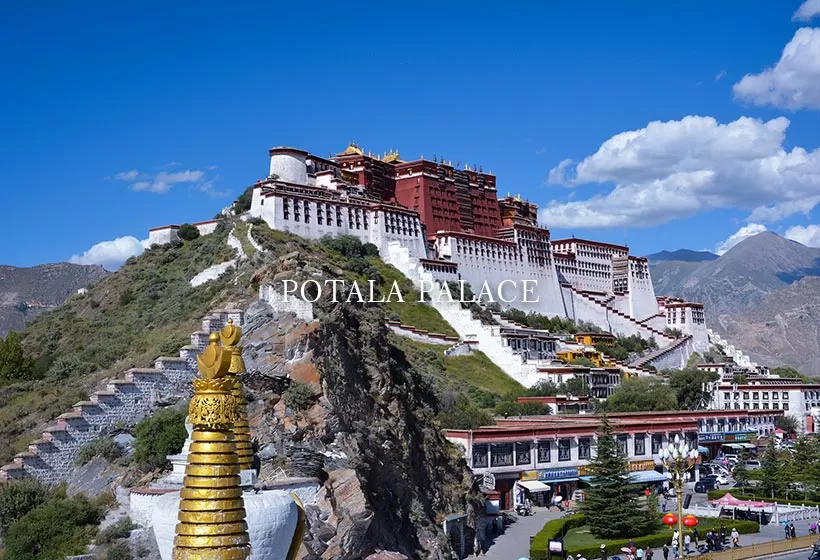Potala Palace, World Heritage Site
The Polata Palace stands erect at the Red Mountain of Lhasa and is the symbol of Lhasa. It is a religious and administrative complex, the significance of which equals that of the Great Wall and the Imperial Palace. It is 3,750 meters above sea level and has 13 stories. Its magnificent view can be seen hundreds of miles away. The Potala Palace has long been listed by UNESCO as a World Heritage Site.
It has an area of more than 100, 000 meters squared and was originally the palace of the Tibetan King Songtsen Gampo and his bride Princess Wen Cheng of the Tang Dynasty. In 1645, the fifth Dalai Lama began construction of the Potala Palace, which was finished in 1694. The Potala Palace had been the residence of the Dalai Lama and the political center of Tibet for centuries.
The Polata Palace is mainly composed of the White Palace (administrative building), the Red Palace (religious building), and the Great West Hall separating the two main palaces. The palace contains about 1,000 rooms, 10,000 shrines, and 200,000 statues. It is famous for its large buildings, complicated architecture, splendid artwork, and spiritual atmosphere.
The White Palace (or Portrang Karpo) is the living quarters of the Dalai Lama. There are also offices, a seminary, and a printing house. A central courtyard separates the living quarters of the Dalai Lama and his monks from the Red Palace which is the religious quarter that contains several gold stupas where the tombs of eight Dalai Lamas are. There are also libraries where Buddhist scriptures are stored, an assembly hall, and numerous chapels and shrines.
The Great West Hall in the middle of the palace is the largest hall there with an area of 725 meters squared. Beautiful murals are painted on inner walls describing the glory of the 5th Dalai Lama and significant historical events like the marriage of Princess Wen Cheng and the building Jokhang Temple. There are three majestic chapels around the Great West Hall.
The ancient Potala Palace presents to visitors not only its splendid architecture but also the precious cultural objects found in the palace. It is the essence of Tibetan ancient architecture and a treasure of Tibetan art.
Potala palace travel guide
The Potala Palace, located in Lhasa, Tibet Autonomous Region, China, is one of the most iconic landmarks and tourist destinations in the world. Here's a travel guide for visiting the Potala Palace:
When to visit: The best time to visit the Potala Palace is from May to October, when the weather is mild and the sky is clear. The palace is closed during the winter months, from November to April.
Tickets and reservations: It is highly recommended that you book your tickets in advance to avoid long queues. Tickets can be purchased online or at the ticket office at the foot of the palace. There is a limit on the number of visitors per day, so it is advisable to book your tickets at least a few days in advance.
Getting there: The Potala Palace is located in the center of Lhasa and can be reached by public transport, taxi, or on foot. If you are staying in the city, it is best to walk to the palace, as it is only a short distance away.
Dress code: Visitors are required to dress modestly, with their shoulders and knees covered. It is also advisable to wear comfortable shoes, as there is a lot of walking and climbing involved.
Touring the palace: The Potala Palace is a huge complex, with over 1,000 rooms and 13 floors. Visitors are only allowed to visit a small portion of the palace, which includes the White Palace, the Red Palace, and the tombs of the Dalai Lamas. A guided tour is recommended, as it will provide you with an in-depth understanding of the history and culture of the palace.
Photography: Photography is allowed inside the palace, but flash photography is prohibited. There is also a ban on selfie sticks and tripods.
Altitude sickness: Lhasa is located at a high altitude, so it is important to take precautions against altitude sickness. It is recommended that you rest for a day or two after arriving in Lhasa, and drink plenty of water to stay hydrated.
The Potala Palace is an iconic landmark and a must-visit destination for anyone visiting Lhasa. By following these tips, you can make the most of your visit and have an unforgettable experience.
GREAT FAMILY CHINA TOUR
JULY 2024 We wanted to thank Grace at China Culture tour for organizing a great tour of China. We enjoyed our Beijing - Xian-Chengdu -Guilin -Yangshuo - Shanghai trip. Our local guides Bruce in Beijing, Susan in Xian, Jane in Chengdu, Mike in Guilin and Mary in Shanghai took care of us…read more details »
Teng Han L from SINGAPORE
Ready to Create a Unique Dream Travel?


